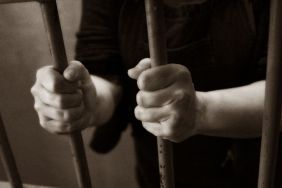
John McNaughton was a thirty-six year old delivery boy, shuffling home video equipment about the offices of Malijack Productions before finally being called in to sit down with small time Windy City producers Malik and Walid B. Ali. At first, the brothers offered the would-be director (whose previous gigs were limited to minor crew positions on tiny TV documentaries around Chicago) an opportunity to helm Dealers of Death, a non-fiction film about the citys history of organized crime. When that picture turned a tiny profit, McNaughton was presented a second documentary project, this time about Chicagos professional wrestling scene. Only when that opportunity fell through (due to a financial dispute over archival footage of 50s matches), the Alis bankrolled him $125,000 to make a horror film.
The director, in turn, hired a janitor with little acting experience to play the lead role of an emotionless drifter who kills for seemingly no reason. Thus Henry: Portrait of a Serial Killerwas born; via the calloused hands of everymen who worked the same blue-collar jobs notorious murderer Henry Lee Lucas couldve easily gotten hired to do in the several towns he passed through.
However, to begin examining Henryanywhere but with Michael Rookers titular role is utterly imprudent, for it is easily one of the best central performances horror cinema has ever offered. The then-inexperienced actor goes completely internal, harnessing a black force in his belly while shielding and disguising that energy with slumped shoulders and pants that are just a touch too short. When he compliments a counter waitress smile, theres a dopey cadence to his masculine candor. Yet as he drives away from this nameless American borough, McNaughton slowly reveals the wake of dead prostitutes and elderly grocery clerks Henrys left behind. Hollowness inhabits his gaze, slack and seeing beyond the blacktop that rolls under his car. For Henry is merely a flesh-suit, harboring an ethereal violence that consumes all in its wake. Akin to the doll-like quality of a great whites eyes Quint (Robert Shaw) describes in Steven Spielbergs Jaws, we see the same void in Rookers stare. He is a shark, always moving and devouring the prey in his path.
This isnt to say McNaughton had little to do with building the eerie sense of stillness that pervades every moment of his movie; quite the contrary, actually. Had McNaughtons original vision for Henrypanned out, we would be considering a much different movie twenty-five years on. Original Director of Photography Jean de Segonzac was considered one of the best hand-held documentary cameramen in 1985, and his fly on the wall style was going to be adopted in order to lend Henrya true, street-level feel. McNaughton was going to let us prowl the alleys with his merchant of death, almost as if we were accomplices. But de Segonzac had to drop the project at the very last minute, leaving McNaughton (who was holding the budget together with shoestrings and glue) to scramble.
What resulted was the hiring of Charlie Lieberman, a cameraman whod helmed a handful of public service videos about substance abuse. The vérité style was thrown out completely, as Lieberman frames each and every shot with a merciless, tableau-centric eye for carnage. Often, the human trash piles Henry creates are captured like crime scene photos, all while the electronic drums in Ken Hale, Steven Jones and Robert McNaughtons score thump, its shrill synths punctuating the chilly Illinois air like reaper wielded scythes. Liebermans meticulously cognizant frame only allows you to see what McNaughton wants. Not once does a police officer come into its 1.37 boxy limits. This is a Midwestern Hellscape without any semblance of law and order; a world without a safety net or an ear to hear you call for help. In essence, Lieberman and McNaughton have created the ultimate portrait of a country on the brink of anarchic apocalypse, its illusion of safety shattered to pieces.
An air of dumb country fornication hangs over our introduction to Otis (Tom Towles) and his sister, Becky (Tracy Arnold). Otis is a sleazy fuckhound, seeing the hunky football players who buy weed off him as sex receptacles just as easily as does his Podunk, stripper sister. Meanwhile, Becky is fleeing a bastard named Leroy, and is highly susceptible to the blunt politeness of her brothers roommate, Henry.
During their initial meet cute (yes, Henryindeed has a meet cute), the mass murderer wouldnt feel too out of place in an Elia Kazan picture, the darkness in his belly morphing into a brusque charm. Only once Becky asks him if he actually killed his mama, the emotion and personality fade away like one of editor Elena Maganinis Movie of the Week-ready dissolves. All thats left is the violence, eager to show its ugly face to this trailer park cherub. Yet Becky, much like the audience, cant look away from the beast, as there is almost a boyish vulnerability at its edges. Like us, she holds on to a naïve belief that she can possibly redeem the abused part of Henry she connects with. Rationalization takes overhis violence is merely a reaction to systematic trauma, none of which is his fault. But the blackness cant even remember the way it dispatched the flesh suits whore mother. Was it with a baseball bat? Did it shoot her? Stab her? Its been doing this so long, the details feel irrelevant at this point in its eternal existence.
McNaughton lets us know during the multiple scenes of explosive violence that any sort of redemption for Henry isnt only a pipe dream, its an incredibly foolish thing to have ever wished for in the first place. Theres a childish glee to the killer as he takes Otis under his wing, each slaughter becoming increasingly more savage, culminating in arguably one of the most chilling acts of violence ever committed to videotape. Brutish rules are passed downbasic guidelines for how to select victims and methods of dispatching so that no fingerprint is ever detected on the crimes, rendering them almost pattern-less. The darkness in Henry recognizes that a lesser quantity of evil exists inside of Otis and coaxes it out under strict tutelage. But Otis is a wild animal, incapable of controlling himself and allowing his savagery to make a complete symbiotic connection with Henrys. To that extent, Otis then becomes a liability, and Henry deals with this danger the same way he casually overcomes every roadblock in his life.
Most peculiar of all is the tone Henry: Portrait of a Serial Killerso completely owns; a droning, dead-eyed gawk that dares the audience to look away. Its a car crash movie, complete with grisly carnage that leaves dead bodies (sometimes quite literally) by the side of the road. Though he may not have been able to fully commit to his fly on the wall style, McNaughton made a movie that feels uniquely voyeuristic. Were peering in at seemingly banal moments that are transmorphed into horror by the fact that monsters are living beside our schoolyards and pumping our gas at filling stations. In this sense, Henryis a quintessential monster movie. Only instead of Dracula lurking in the drafty corridors of a castle, Henry Lee Lucas lives in the apartment next door. Theres a reason the movie stunned an entire audience into silence at the 1989 Telluride Film Festival, leading to walkouts and even confrontations with McNaughton*. His movie invades our privacy and demolishes the boundaries between reality and fiction in a way few pictures ever have.
Its this tone and invasiveness that partially led to the movie going unreleased for nearly half a decade. Completed in 1986, the film was deemed unable to be distributed without an X rating by the MPAA, who first cited the films violent content before reckoning that the overall pervasive sense of dread rendered it impossible to trim down in order to achieve an R. Much like its animalistic subject, Henrydrifted in and out of a filmic no-man’s-land, publicly screening in a video version at the 1986 Chicago Film Festival, where it received stunned, angry reviews. Brave programmers slotted the film at midnight screenings in New York (where the Village Voice’s Elliott Stein called it one of the best American films of the year), but no mainstream distributor would touch it with a ten-foot pole due to the MPAAs scarlet letter.
The Ali brothers were equally baffled by the picture, taken aback that McNaughton hadnt delivered a simple slasher, but instead a complex portrait of evil incarnate. So the film sat on the shelf, until finally it was released Unrated at the 1989 Telluride Film Festival and hit NYC indie houses on 16mm twenty-five years ago.
In his original review, Roger Ebert proposed that it be the first candidate for the A rating an Adults Only classification for non-pornographic films. The movies controversial existence coincided with Peter Greenways The Cook, The Thief, His Wife & Her Lover, both of which are credited by many as the reason the MPAA created the NC-17 label. In the UK, it would take another thirteen years for the movie to be deemed certifiable by British Board of Film Classification completely uncut, having been censored on no less than three separate occasions by the board. In 1992, New Zealands Office of Film and Literature Classification out and out banned the movie, making it unavailable on home video until 2010.
Watching the film twenty-five years on, these reactions still seem somewhat understandable. Possibly the most terrifying aspect of Portrait isnt the fact that Henry could be living next door or hiding in the alley, just waiting for us to stumble out of a bar or fumble with our keys while getting into the car. No, the most petrifying aspect of the picture is that he could secretly live inside your house or even your heart. In the end, Portrait of a Serial Killerbecomes so much more than a loosely autobiographical jaunt through the frigid stomping grounds of a bloodthirsty land shark. Instead, McNaughtons film acts as veritable lightning in a bottle; the capture and containment of unrelenting evil personified. Theres a reason the MPAA didnt want the nations children to witness this picture. Its because Henryis a mirror they can look into, hopeless against a devils face that could be staring back from the looking glass. The capacity for evil exists inside of every human being. Henry could be you. He could be me. Henry could be anybody.
*The legend goes: as McNaughton was exiting the theater, an audience member said you cant do this, to which the director bluntly retorted we just did.
Jacob Knight is an Austin, Texas based film writer who moonlights as a clerk at Vulcan Video, one of the last great independent video stores in the US. You can find find him on Twitter @JacobQKnight.








